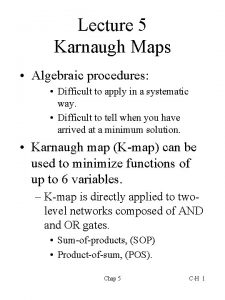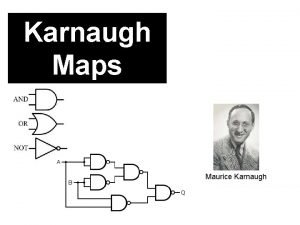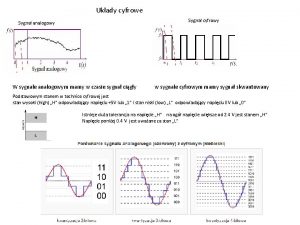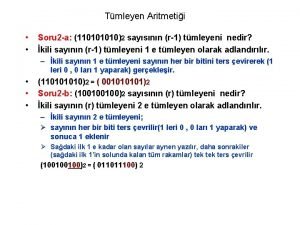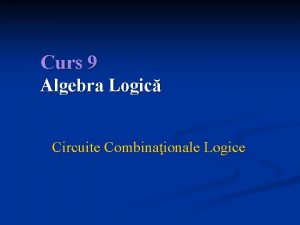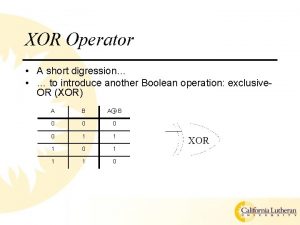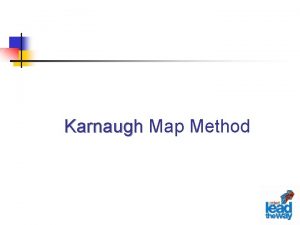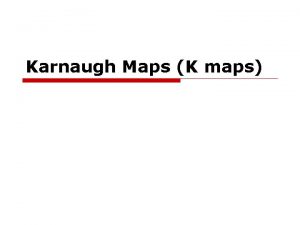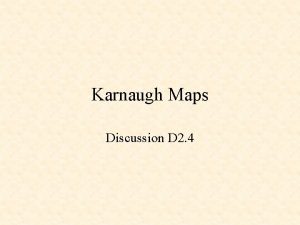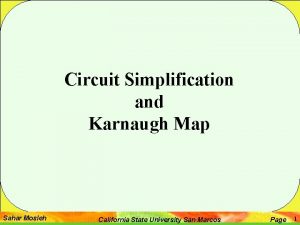CHAPTER 4 The Karnaugh Map The Karnaugh Map


























- Slides: 26

CHAPTER 4 The Karnaugh Map

The Karnaugh Map • Provides a systematic method for simplifying Boolean expressions • Produces the simplest SOP or POS expression • Similar to a truth table because it presents all of the possible values of input variables

The 3 -Variable K-Map

The 4 -Variable K-Map

K-Map SOP Minimization • A 1 is placed on the KMap for each product term in the expression. • Each 1 is placed in a cell corresponding to the value of a product term

Mapping Standard SOP Expression Example: Map the following standard SOP expression on a K-Map: Solution:

Map the following standard SOP expression on a K-Map: Example: Solution:

Exercise: Map the following standard SOP expression on a K-Map:

K-Map Simplification of SOP Expressions A group must contain either 1, 2, 4, 8 or 16 cells. Each cell in group must be adjacent to one or more cells in that same group but all cells in the group do not have to be adjacent to each other Always include the largest possible number 1 s in a group in accordance with rule 1 Each 1 on the map must be included in at least one group. The 1 s already in a group can be included in another group as long as the overlapping groups include noncommon 1 s To maximize the size of the groups and to minimize the number of groups

Example: Group the 1 s in each K-Maps

Determining the minimum SOP Expression from the Map • Groups the cells that have 1 s. Each group of cells containing 1 s create one product term composed of all variables that occur in only one form (either uncomplemented or complemented) within the group. Variable that occurs both uncomplemented and complemented within the group are eliminated. These are called contradictory variables.

Determining the minimum SOP Expression from the Map • For 3 -variable map: 1) A 1 cell group yields a 3 variable product term 2) A 2 -cell group yields a 2 -variable product term 3) A 4 cell group yields a 1 variable term 4) An 8 cell group yields a value of 1 for the expression

Determining the minimum SOP Expression from the Map • For 4 -variable map: 1) A 1 cell group yields a 4 variable product term 2) A 2 -cell group yields a 3 -variable product term 3) A 4 cell group yields a 2 variable term 4) An 8 cell group yields a 1 variable term 5) A 16 cell group yields a value of 1 for the expression

Example: Determine the product term for the K-Map below and write the resulting minimum SOP expression 1


Example: Use a K-Map to minimize the following standard SOP expression

Example: Use a K-Map to minimize the following standard SOP expression

Mapping Directly from a Truth Table

Don’t Care (X) Conditions • A situation arises in which input variable combinations are not allowed • Don’t care terms either a 1 or a 0 may be assigned to the output

Don’t Care (X) Conditions Example of the use of “don’t care” conditions to simplify an expression

Exercise: Use K-Map to find the minimum SOP from 1 2

K-Map Simplification of POS Boolean Expression • A 0 is placed on the K-map for each sum term in the POS expression. • Mapping a Standard POS Expression – Step 1: Determine the binary value of each sum term in the standard POS expression. – Place a 0 on the K-map in the corresponding cell.

Example: F=(A+B+C)(A+B+C)(A+B+C) The combination of binary values: (0 + 0)(0 + 1)(0 + 1 +0)(0 + 1)(1 + 0) The resulting minimum POS is: A ( B + C)

Converting Between POS and SOP Using the K-Map • For a POS expression, all the cells that do not contain 0 s contain 1 s, from which the SOP expression is derived. • Likewise, for an SOP expression, all the cells that do not contain 1 s contain 0 s, from which the POS expression is derived.

Example: • Using a K-map, convert the following standard POS expression into a minimum POS expression, a standard SOP expression, and a minimum SOP expression. • ( A + B + C + D)(A + B + C+ D)(A+ B + C + D)(A + B + C + D)

 Karnaugh map is made up of
Karnaugh map is made up of Penyederhanaan k-map 4 variabel
Penyederhanaan k-map 4 variabel Penyederhanaan dengan karnaugh map f = ab' + a'b + ab
Penyederhanaan dengan karnaugh map f = ab' + a'b + ab Karnaugh map probability
Karnaugh map probability Pos k map
Pos k map Don't care condition in k map
Don't care condition in k map Dr karnaugh
Dr karnaugh Karnaugh map method
Karnaugh map method Five variable k map
Five variable k map Karnaugh map
Karnaugh map Boole
Boole Maurice karnaugh
Maurice karnaugh Contoh soal peta karnaugh
Contoh soal peta karnaugh Maurice karnaugh
Maurice karnaugh Sistemas digitales
Sistemas digitales Circuitos
Circuitos Biểu đồ karnaugh 4 biến
Biểu đồ karnaugh 4 biến Wyświetlacz 7-segmentowy tablica karnaugh
Wyświetlacz 7-segmentowy tablica karnaugh Karnaugh haritası soruları
Karnaugh haritası soruları Karnaugh diagramm 5 variablen
Karnaugh diagramm 5 variablen Peta karnaugh 3 peubah
Peta karnaugh 3 peubah Mappe di karnaugh esempi
Mappe di karnaugh esempi Diagrama karnaugh 4 variabile
Diagrama karnaugh 4 variabile Karnaugh kmap xor patterns
Karnaugh kmap xor patterns Mapa de karnaugh maxtermos
Mapa de karnaugh maxtermos 5 változós karnaugh tábla
5 változós karnaugh tábla Karnaugh diyagramı
Karnaugh diyagramı




